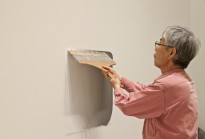A Modest Encounter with Lee Ufan
A modest encounter in line with ecstasy is how renowned Korean born artist Lee Ufan, 75, describes his unrestricted and infinite art. Ranging from painting and sculpting to writing and philosophy, Ufan’s endeavors are endless and groundbreaking, as he penetrates the contemporary art world through his spiritual ways.
But that is not what makes him unique. Rather it is his desire to showcase “the jargon of the universe” as well as his methodology of linking words and art as one – an ongoing dialogue and unity between art forms and people.
In an exclusive interview for GALO, Ufan brings light to his art, explains his love for literature, and tells us his most memorable moment at the Guggenheim Museum in New York, whilst preparing for his ongoing Marking Infinity exhibition.
GALO: When did your interest in art first develop?
Lee Ufan: From my childhood, I learned to draw and paint. But as I grew older, I started showing more interest in literature, to the point where I wrote my own novels. Meanwhile, I also took [an interest in] music, on which I worked with deep concern, so I once wanted to become a composer. It is due perhaps to my countryside background that I was slightly timid, which made me lean more toward art instead of other areas.
GALO: Why did you decide to pursue this interest professionally?
LU: It was probably the difficulty of language that stood between me and my willingness to achieve something in literature, and naturally, art became my main activity of concern. I, of course, chose visual art out of all other art forms, but the imaginative power that generated a force of drive in working at it sustained me throughout my life as an artist.
GALO: In your biography it says that you studied painting at the Seoul National University’s College of Fine Arts for two months, at which point you transferred to Nihon University in Tokyo and majored in philosophy. Why did you leave your studies in Korea for those in Japan, and why did you not continue studying the Fine Arts, while in Japan, and instead chose philosophy?
LU: The choice to study art in university was enforced by my entourage, rather than my own will. There it became tedious. During those days, I had an order from my father to deliver some oriental medicine to my uncle who was at the time suffering from a serious illness. As I arrived in Japan, I was convinced by him to study in Japan. My compliance with the recommendation took me to the philosophy department of a university, where I fell in love with reading and contemplation.
GALO: Has this elicited a challenge for you within the art community?
LU: It was indeed my knowledge and groping in philosophy that allowed me to sublimate my thinking into an expressive form in art, but there is also the factor of perception that directs and projects my thinking into the world. It certainly requires the strength of learning, bodily practice and understanding, to command a respectable work of expression.
GALO: Has your knowledge of philosophy helped you with your artwork? Has it helped with your creativity and understanding of art?
LU: If a work of art goes just as far as [an] extent of its expression of [a] idea per se, there is simply no joy in working. My learning and thoughts on various philosophèmes were for certain of a great importance in my inquiries into higher and deeper dimensions. But what is more crucial in such [a] stance of an artist is not [very] much ingrained in the idea itself, but the attitude which has to be philosophical.
GALO: Is there a particular philosopher who you most admire and that has inspired you?
LU: Among the thinkers I was influenced by, there are: Heraclitus, Lao-tze and Zhuangzi, as well as Kant, Heidegger, Merleau-Ponty and Kitaro Nishida.
GALO: What does art mean to you?
LU: Art is the spiritual provision that enlightens one on the next level of sublimity of life.
(Article continued on next page)

